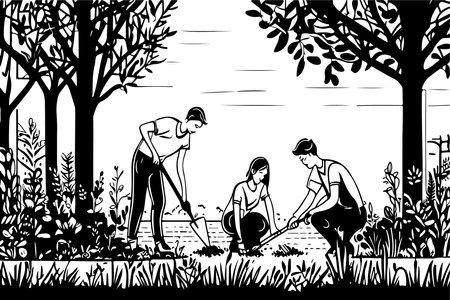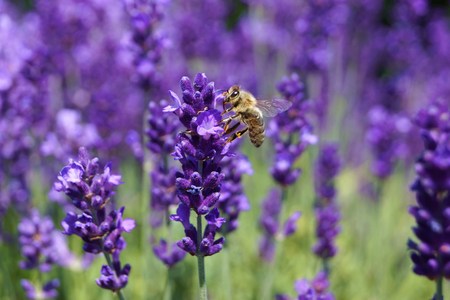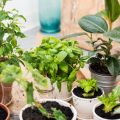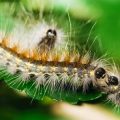Understanding Pesticides and Their Effects
Pesticides are a common sight in American gardens, ranging from insecticides and herbicides to fungicides. While they are often used to control unwanted pests and promote plant growth, their widespread application can have far-reaching consequences. Insecticides, for example, may target harmful bugs but can also inadvertently harm essential pollinators like bees, butterflies, and even hummingbirds. Herbicides designed to kill weeds might disrupt the delicate balance of native plant species that many pollinators depend on for nectar and habitat. Beyond affecting wildlife, these chemicals seep into the soil, impacting microbial life and reducing soil health, which is vital for sustainable gardening. Runoff from treated lawns and gardens can enter nearby waterways, causing further damage to aquatic ecosystems. Understanding these direct and indirect impacts is crucial for anyone who wants to create a thriving, environmentally friendly garden that supports both people and pollinators.
2. Why Pollinators Matter
Pollinators are the unsung heroes of our ecosystems, playing an essential role in food production, biodiversity, and overall environmental health across the United States. From bees and butterflies to hummingbirds and bats, these creatures facilitate the reproduction of flowering plants by transferring pollen from one bloom to another. This process is not only crucial for wild plants but also for many of the crops we rely on every day.
The Role of Pollinators in U.S. Food Production
Pollinators are responsible for one out of every three bites of food Americans consume. Without them, our plates would look much less colorful and nutritious. The following table highlights some common crops in the U.S. that depend on pollinators:
| Crops | Primary Pollinator(s) | Importance |
|---|---|---|
| Apples | Honey bees, native bees | Increased yield and quality |
| Almonds | Honey bees | Essential for fruit set |
| Blueberries | Bumble bees, solitary bees | Larger berries, better harvests |
| Pumpkins & Squash | Squash bees, bumble bees | High pollination needed for full-size fruit |
| Cranberries | Bumble bees, honey bees | Improved berry size and uniformity |
Biodiversity and Healthy Ecosystems
Beyond our farms and gardens, pollinators are fundamental to sustaining native plant populations and supporting wildlife habitats. By enabling plants to reproduce, they help maintain diverse plant communities that provide food and shelter for countless other organisms—from birds to insects to mammals. This interconnected web keeps our ecosystems resilient and thriving.
The Ripple Effect of Pollinator Decline
If pollinator populations continue to decline due to pesticide use and habitat loss, the ripple effects could be devastating—not just for agriculture but also for the health of natural landscapes across America. Protecting pollinators means protecting the intricate balance of life that sustains us all.

3. Recognizing Pollinator-Friendly Plants
When it comes to gardening organically for pollinators, choosing the right plants is key to creating a sustainable and thriving ecosystem. Native American plants are particularly valuable because they have co-evolved with local pollinators such as bees, butterflies, and hummingbirds, offering the ideal nectar and pollen resources these species rely on. By selecting native flora, gardeners can help restore natural habitats while supporting biodiversity.
Why Native Plants Matter
Native plants are adapted to the local climate and soil conditions, requiring less water and fewer resources than non-native species. They also tend to be more resilient against pests, reducing the need for chemical interventions that can harm pollinators. Plus, native flowers bloom in sync with the lifecycles of local pollinators, ensuring there’s always a food source available throughout the growing season.
Top Pollinator-Friendly Native Plants
Consider incorporating these standout native American plants into your organic garden:
For Bees
- Wild Bergamot (Monarda fistulosa): Its lavender blooms are a favorite among native bumblebees and honeybees.
- Purple Coneflower (Echinacea purpurea): This hardy perennial offers abundant pollen and nectar throughout summer.
- Goldenrod (Solidago spp.): A late-season bloomer that provides crucial resources when other flowers fade.
For Butterflies
- Milkweed (Asclepias spp.): Essential for Monarch butterfly caterpillars and adults alike.
- Black-Eyed Susan (Rudbeckia hirta): Bright yellow petals attract swallowtails and painted ladies.
- Blazing Star (Liatris spicata): Spiky purple flowers loved by migrating butterflies in late summer.
For Hummingbirds
- Trumpet Honeysuckle (Lonicera sempervirens): Tubular red blossoms perfect for hummingbird beaks.
- Columbine (Aquilegia canadensis): Early spring blooms offer vital nectar after migration.
- Cuphea (Cuphea ignea): Although not always native, this plant is widely used in American gardens for its continuous blooms that attract hummingbirds all season long.
Selecting a mix of these native species ensures a succession of blooms from spring through fall. By planting with purpose, you’ll create an organic sanctuary that sustains pollinators while embodying eco-friendly and sustainable gardening practices.
4. Organic Gardening Methods
Transitioning to organic gardening is a powerful way to protect pollinators and support the environment, especially when tailored to diverse U.S. climates. By embracing sustainable, chemical-free practices, gardeners can enrich their soil, naturally manage pests, and foster biodiversity without relying on synthetic pesticides or fertilizers.
Soil Enrichment: Building Healthy Foundations
Healthy soil is the cornerstone of any organic garden. Instead of using chemical fertilizers, focus on amending your garden beds with natural materials that improve soil structure and boost fertility. Compost, aged manure, leaf mold, and cover crops are all excellent choices that add nutrients while supporting beneficial microbes.
| Region | Recommended Soil Amendments |
|---|---|
| Northeast & Midwest | Compost, shredded leaves, worm castings |
| Southeast | Pine needles (for acidity), composted bark |
| Southwest | Mulch (to retain moisture), green manure cover crops |
| Pacific Northwest | Fish emulsion, seaweed extract, leaf mold |
Natural Pest Management Strategies
Chemical pesticides harm pollinators, but organic gardens can thrive with ecological pest control methods. Start by attracting beneficial insects such as ladybugs and lacewings that prey on common pests. Use physical barriers like row covers to protect plants during vulnerable stages and rotate crops each season to disrupt pest life cycles.
Common Organic Pest Solutions by Climate:
| Climate Zone | Pest Challenge | Organic Solution |
|---|---|---|
| Hot & Humid (e.g., Southeast) | Aphids, fungal diseases | Neem oil spray, plant spacing for airflow |
| Arid (e.g., Southwest) | Caterpillars, mites | Bacillus thuringiensis (Bt), diatomaceous earth dusting |
| Mild & Wet (e.g., Pacific NW) | Slugs, snails | Copper tape barriers, hand-picking at dusk/dawn |
| Cold Winters (e.g., Midwest/Northeast) | Cabbage worms, beetles | Floating row covers, crop rotation with legumes |
Companion Planting for Biodiversity and Pollinator Health
Companion planting not only deters pests but also provides continuous food sources for pollinators throughout the growing season. By pairing compatible species together, you create a resilient ecosystem that reduces the need for chemical intervention and supports bees, butterflies, and other vital insects.
Popular Companion Plant Pairs for U.S. Gardens:
| Main Crop | Companion Plant(s) | Benefits for Pollinators & Pest Control |
|---|---|---|
| Tomatoes | Basil, marigold, borage | Borage attracts bees; marigolds deter nematodes; basil improves flavor and repels flies. |
| Cucumbers/Melons | Nasturtium, dill, sunflowers | Nasturtiums attract aphids away; dill brings predatory wasps; sunflowers provide pollen for bees. |
| Cabbage Family (brassicas) | Sage, thyme, alyssum | Alyssum draws in hoverflies; herbs confuse cabbage moths. |
By integrating these organic methods into your gardening routine and adapting them to your regional conditions, you can create a thriving sanctuary for pollinators while cultivating healthy food and vibrant landscapes—all without harmful chemicals.
5. Creating Safe Habitats for Pollinators
Transforming your garden into a pollinator-friendly haven is an empowering step toward sustainability and ecosystem health. Beyond going pesticide-free, providing essential resources like shelter, water, and nesting sites ensures that bees, butterflies, hummingbirds, and other beneficial insects can thrive.
Shelter: Build a Refuge from the Elements
Pollinators need places to rest, hide from predators, and take shelter from weather. Incorporate native shrubs, tall grasses, and layered plantings to create natural cover. Leave some areas of your yard a little “wild”—a brush pile or log left undisturbed becomes a safe home for ground-dwelling bees and beetles. Resist the urge to tidy up every fallen leaf; leaf litter provides vital winter refuge for many beneficial insects.
Water Sources: Quenching Pollinators’ Thirst
Even small gardens can offer water for pollinators. A shallow birdbath with stones or marbles gives bees and butterflies a place to land safely while drinking. Change the water regularly to prevent mosquito breeding. In drier regions, consider creating a mud patch—many native bees use mud for nest-building or mineral intake.
Nesting Sites: Support Next Generation Pollinators
Diverse pollinators have diverse nesting needs. Install bee hotels made from untreated wood or bundles of hollow stems for solitary bees. Leave bare patches of soil in sunny spots—about 70% of native bee species nest underground! If you have old tree stumps or dead wood, let them remain where safe; they provide critical habitat for carpenter bees and other wildlife.
Go Native for Lasting Impact
Whenever possible, choose regionally native plants—they’re better adapted to local climate conditions and support the greatest diversity of pollinators. Native milkweed hosts monarch caterpillars, while coneflowers and goldenrods feed adult butterflies and bees throughout the season.
Community Action: Share Your Success
Your garden can be an inspiration for others in your neighborhood. Display a pollinator habitat sign or host a garden walk to share what you’ve learned about gardening organically and sustainably. By working together, we can help restore pollinator populations and build healthier communities—one backyard at a time.
6. Community Resources and Local Initiatives
Supporting pollinator health and practicing organic gardening don’t have to be solo efforts. Across the United States, a variety of organizations, community gardens, and programs are dedicated to promoting pollinator-friendly environments and providing resources for gardeners who want to go pesticide-free. By tapping into these networks, you can connect with like-minded neighbors, access educational workshops, and find native plant swaps that make sustainable gardening more accessible.
American Organizations Making a Difference
National groups like The Xerces Society for Invertebrate Conservation and Pollinator Partnership offer extensive guides on pollinator-safe practices, habitat creation, and advocacy for reducing pesticide use. These organizations also coordinate events such as Pollinator Week each June, inviting communities to learn about and celebrate bees, butterflies, bats, and other essential pollinators.
Local Community Gardens
Many American towns and cities host community gardens—shared spaces where residents can grow their own food organically while fostering biodiversity. Projects like the American Community Gardening Association (ACGA) help connect you with local initiatives that prioritize pollinator habitats, often featuring sections dedicated to native wildflowers or “bee hotels.” Volunteering or becoming a member is a great way to share resources, seeds, and knowledge about organic methods.
Sustainable Gardening Programs & Support
States like California, Oregon, and Vermont have robust Master Gardener Programs, which provide classes on organic gardening techniques and sustainable landscaping tailored for your region. Many municipalities now sponsor “No Mow May” campaigns or encourage residents to join “Bee City USA” or “Monarch City USA,” both of which recognize communities committed to pollinator protection through reduced pesticide use and increased native plantings. Check your local extension office or city website for grants, free compost giveaways, or educational seminars focused on eco-friendly gardening.
By participating in these community resources and local initiatives, you’re not just helping pollinators—you’re joining a movement toward healthier neighborhoods and a more resilient environment for everyone. Every backyard counts!


